Wearables are improving the clinical trial experience for patients and satisfying the need to collect data for real-world use studies.
Experts agree: future drug development will be based on broader, real-time patient data.
Connected health, which includes wearable devices and mobile health (mHealth) technology, is providing the industry with an opportunity for patient-centric data generation.
Currently, about 10% to 15% of trials are incorporating wearable devices, primarily to collect data as exploratory endpoints. But industry experts say there is a push for wearables to be a bigger part of efforts to improve 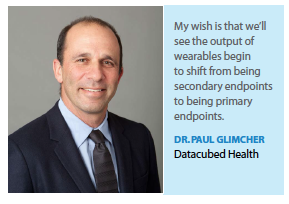 patients’ experience with clinical trials and to collect data for real-world use studies.
patients’ experience with clinical trials and to collect data for real-world use studies.
Biopharma companies and their partners have been investing in wearable technology and analytics for some time with the goal to give sponsors a continuous real-time patient view, as opposed to isolated snapshots gathered at healthcare sites.
Implementing wearable devices and mHealth into clinical drug development has many advantages. In addition to reducing the burden on patients by decreasing or even eliminating follow-up visits to research centers, data collection can be done over a wider window of time to provide complete tracking of physiologic parameters, medication administration, and adherence to clinical study activities.
“Mobile sensors that are now ubiquitous with patients can be leveraged to provide information that can help us as a pharmaceutical company develop 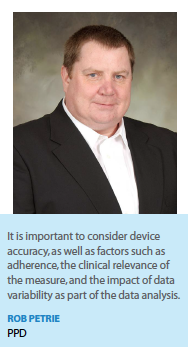 new compounds," says Christian Gossens, Ph.D., global area head, digital biomarkers, Roche Research & Development.
new compounds," says Christian Gossens, Ph.D., global area head, digital biomarkers, Roche Research & Development.
The two main consumer activity trackers on the market today — the Fitbit and Apple Watch — are currently capable of monitoring vital signs such as heart rate, respiratory data, exercise, and movement levels. Industry experts say there is growing excitement around the use of other types of wearables, including inserts for shoes, such as Apple’s ResearchKit that tracks the gait of patients with Parkinson’s disease.
When wearables were first considered for trials, companies initially looked to Fitbit and other consumer devices, but they didn’t meet regulatory requirements. Clinical grade devices such as those offered by Phillips and ActiGraph filled a void. Now, consumer devices are improving in quality, and are starting to be recognized by the FDA. For example, the Apple Watch Series 4 received FDA clearance last fall when it was introduced for atrial fibrillation-detecting algorithm and ECG.
“Consumer devices are lightweight and easy for patients to use, making it easier for those interested in participating in trials," says Karin Beckstrom, innovation lab, senior product manager, ERT. “They’re built for everyday use and with a wide variety of users in mind. Clinical grade devices are a little more cumbersome than consumer devices yet provide stable quality data."
The use of wearables that capture cardiac data, industry leaders say, is an exciting development, providing opportunities to use these devices for measuring primary endpoints.
“We’re increasingly seeing real-time physiologic data being used in a more exploratory sense," says Michelle Longmire, CEO, Medable. “In a Phase II or Phase III study, companies want to develop a digital biomarker or use real-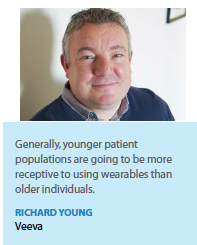 time physiologic data, heart rate, skin temperature, respiratory rate, etc., to develop a physiologic signature of a particular state, like fatigue or weight loss or heart failure."
time physiologic data, heart rate, skin temperature, respiratory rate, etc., to develop a physiologic signature of a particular state, like fatigue or weight loss or heart failure."
Kaiser Associates, with research conducted by Intel, estimates that by 2025, 70% of clinical trials will incorporate sensors. This is significant because 99.9% of patient health-related activity happens outside of a hospital or clinic, according to EHR Intelligence.
Connected devices can make trials more patient-centric and generate endpoints that are viewed to have greater value, says Marie McCarthy, senior director, product innovation, ICON. “Since joining ICON five years ago, I have witnessed a significant change in the use of digital technologies in clinical trials," she says. “Previously wearables were viewed as niche and the value hadn’t been established or perceived to be worthwhile. Now, we’re seeing the use of wearables to manage patients in their own home environment outside of the clinic as having huge value."
Experts say over the next five years, there will be a seismic shift in the use of wearables and they will become a central component in understanding how patients go about their daily lives, which is key to obtaining physiological datasets from patients.
“Companies want to prove that a medication has a positive impact on a patient’s real life, and by adding sensory data combined with the patient voice can help prove effectiveness," Ms. Beckstrom says.
As companies continue to shift their mindset toward thinking holistically about how technology can be used to improve clinical research, Josh Rose, VP and global head of strategy, IQVIA, says there will be even more interest in the role connected devices can play in clinical studies.
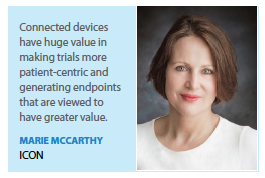 “In addition to the convenience for patients, the quality of data is higher with connected devices because the error rates are reduced and the data sets are cleaner," he says.
“In addition to the convenience for patients, the quality of data is higher with connected devices because the error rates are reduced and the data sets are cleaner," he says.
“My wish is that we’ll see the output of wearables begin to shift from being secondary endpoints to being primary endpoints," says Paul Glimcher, Ph.D., CEO and founder, Datacubed Health.
Pharmaceutical Companies and Wearables
Roche is one of the many companies now using wearables as part of their clinical development programs. The company began its wearable platform in February 2015 in a proof-of-concept trial involving 43 Parkinson’s disease patients and 35 healthy volunteers.
“It’s difficult to conceive from today’s perspective, but at the time, there were questions as to whether the Institutional Review Board would accept a wearable as part of the interventional clinical trial," Dr. Gossens says. “The second challenge was if the patient population — in this case, mainly elderly men — would adopt the device. At that time, there was still speculation that elderly people wouldn’t embrace mobile technology."
Dr. Gossens says there were additional concerns that the sensors would not correlate in any meaningful way with established standards or provide additional insights. “In the end, we found our active tests detect significant PD-like symptoms. Also, by passively collecting the raw data while patients just go about their daily activities, we had an enormous rich dataset that provided unique additional insights using machine learning. The study showed strong correlation between remotely collected sensor signals and in clinical assessments."
Since then, advances in technology have made designing new specific tests and analyzing the data collected from wearables much more manageable.
“When we kicked off this first proof-of-concept study about five years ago, we calculated that the study would generate around a terabyte of data," Dr. Gossens says. “In perspective, a terabyte of data doesn’t seem so frightening anymore."
In 2016, Roche initiated a proof-of-concept study in MS — Floodlight — which evaluated 76 patients and 25 controls continuously with a tailored remote monitoring smartphone and wearable over 24 weeks. Patients were asked to also complete specifically designed daily tests on their smartphones to evaluate mood, symptoms and disease impact, related to cognition, balance, ability to walk, pinch and draw shapes, all of which mirrored other clinically validated endpoints. This assessment suite was extended last year into an open access trial — floodlightopen.com — leveraging a bring-your- own device approach. Roche is now using tailored approaches across the neuroscience portfolio, e.g. in indications such as Huntington’s disease, SMA, and schizophrenia.
own device approach. Roche is now using tailored approaches across the neuroscience portfolio, e.g. in indications such as Huntington’s disease, SMA, and schizophrenia.
Another company working with wearables and connected devices is Janssen Pharmaceuticals. In January, the company entered into a research study in collaboration with Apple to investigate whether a new heart health program using a J&J app in combination with Apple Watch’s irregular rhythm notifications and ECG app can accelerate diagnosis and improve health outcomes. 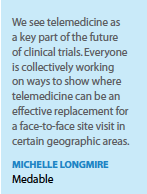 The study aims to analyze the impact of Apple Watch on the early detection and diagnosis of atrial fibrillation, and the potential to improve outcomes, including the prevention of stroke. This multi-year research program will be launched in the middle of 2019, says Paul Burton, M.D., Ph.D., VP, medical affairs, internal medicine, Janssen Scientific Affairs.
The study aims to analyze the impact of Apple Watch on the early detection and diagnosis of atrial fibrillation, and the potential to improve outcomes, including the prevention of stroke. This multi-year research program will be launched in the middle of 2019, says Paul Burton, M.D., Ph.D., VP, medical affairs, internal medicine, Janssen Scientific Affairs.
“The primary aim is to look at rates of atrial fibrillation in the real world, using the Apple Watch," he says. “I believe we will show there is greater incidence of atrial fibrillation than anybody imagines. We want to show that by alerting people to the condition and directing them to the standard of care, we can show a reduction in the risk of stroke."
He says in the coming decades wearable and digital technology will play a key role in improving patient outcomes.
“This type of collaboration between digital and wearable technology and healthcare requires a level of robust clinical science," he says. “We are committed to science and to transforming the trajectory of healthcare through clinical research."
Insights from the Data
Data analytics technologies are advancing to keep pace with the vast amounts of data received from wearables and connected devices. The volume of clinical data being collected from numerous and disparate data sources has grown dramatically in response to the rising scope and complexity of clinical trial protocol, according to the Tufts Center for the Study of Drug Development. It is expected that more data will be generated in 2019 alone than in the last 5,000 years.
And it’s not just wearables that are contributing to the volume. Electronic clinical outcome assessments, mobile devices, social media communities, and electronic health/medical records are but a few examples of new and diverse sources of data now captured during a clinical trial.
“Ten years ago, there were a million data points in a big Phase III study," says Richard Young, VP of clinical data, Veeva. “Today, we are talking about collecting millions of data points per patient per day. The next challenge is incorporating this wealth of data into an everyday data management solution."
Applying machine learning can help to pull out trends and anomalies, Ms. Beckstrom says. “By layering in analytics, we can pick up subtle trends; this is when the data start to become meaningful."
While remote assessment technologies can bring a lot of scientific value to clinical research, they also have highlighted the need to change existing processes, roles, and systems.
“In our experience, we have found it takes time to develop mature, flexible processes and systems that can robustly handle the relative heterogeneity that exists in the wearable space, while being sure to satisfy regulatory needs," Rob Petrie, PPD’s chief technology officer, explains. “Due to their relative novelty, it is very important for sponsors to consider experience when selecting a partner to conduct a trial that includes wearables."
The maturity, flexibility, and data gathering ability of wearables continues to grow at an exponential rate in the consumer and medical-grade space; however, the improvement of technology in this space has far exceeded adoption and use in clinical research. “Through experience, we have learned that the true barrier to success is no longer the available technology, but the ability of the clinical research industry to develop new processes and methods to effectively utilize them," Mr. Petrie says.
“Endpoints such as blood pressure collected by a patch can vary widely from the more traditional cuff, while the measurement can be clouded further by patients improperly following instructions.
“If a patient does not follow the instructions of sitting quietly for three minutes before taking his or her blood pressure, for example, then the accuracy of the endpoint cannot be focused only on the device," Mr. Petrie continues. “It is therefore important to not only consider the device’s 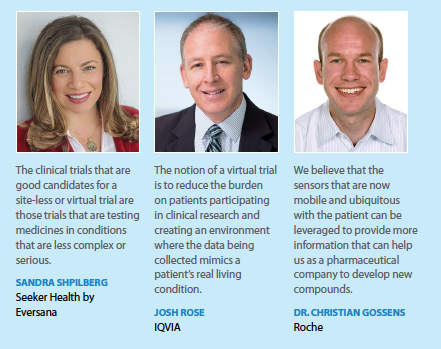 accuracy, but other factors such as adherence, the clinical relevance of the measure, and the impact of variability to the data analysis."
accuracy, but other factors such as adherence, the clinical relevance of the measure, and the impact of variability to the data analysis."
If used correctly, wearables have the unique ability to enable study staff to quickly enhance adherence. “If the devices allow for real-time or near-real time monitoring, call plans and retention strategies can be rapidly implemented by the study staff," Mr. Petrie says.
The best wearable is non-invasive, Dr. Glimcher says. “Patients should hardly know that they have anything to do with the device," he says.(PV)
~~~~~~~~~~~~~~~~~~~~~~~~~
Five Steps to Wearable Trial Success
1: Embrace a “win fast, fail fast" model with proof of concepts (POCs). POCs provide a necessary and valuable approach for pharmaceutical companies to test confidently and practically the feasibility of new technologies. POCs are the best way to learn how to use and maximize value from wearables and other technologies, especially in an industry unaccustomed to an expedited approach.
2: Be clear about who owns the POC and how it will be funded. Best practice companies dedicate funding and an independent team to drive innovation in R&D, with the ability to test technologies quickly and cascade the learning through the broader organization.
3: Start outlining a foundational data strategy. Particularly in the case of wearables, the amount of collectable data can often be overwhelming and not always necessary. Having a clear data strategy upfront is essential, impacting everything from informed consent to protocols and data security.
4: Go outside your firm — involve key stakeholders, including patients and physicians, early and often. Clinical trial protocols cannot be developed in isolation, especially when it comes to incorporating wearables or other digital health innovations. Viewing patients as technology consumers rather than as patients is critical. Failure to consider these factors runs the risk of poor data and lack of compliance.
5: Ensure that stakeholder-specific KPIs and learning goals are incorporated. When considering incorporating wearables into a clinical trial, it is important to know exactly what endpoints are needed, how they will be analyzed and who will use them (e.g., payers, regulators, physicians, others).
Source: IQVIA
~~~~~~~~~~~~~~~~~~~~~~~~~
Virtual Trials
There is an opportunity for wearables and connected health to make it easier on patients to participate in clinical trials — by limiting the number of doctor visits patients need to make.
From a patient-centricity viewpoint, wearables can lessen the burden on patients and increase patients’ willingness to participate in a trial, says Rob Petrie, PPD’s chief technology officer.
Wearables can have a particularly positive impact on patients with rare diseases who may be located far from sites. “If several site visits can be replaced by wearable data collection, this could be a crucial deciding factor for participation for a subject," Mr. Petrie says.
Kara Dennis, senior VP and general manager of life sciences, Clarify Health Solutions, predicts that the future will be hybrid studies, where some site visits will be required for initial measurements, consent, or other elements of the trial and then patients will be able to produce or submit data or otherwise participate in a trial remotely.
“A trial where some site visits, if not all, can be eliminated has the potential to reduce the burden on patients substantially and increase the ability to recruit patients," she says. “There is the potential to get clinically meaningful data and provide a more continuous and more comprehensive picture of the patient. It is going to be really interesting to watch what happens in the next couple of years."
Michelle Longmire, CEO of Medable, says digital technologies are already leading to the reduction in site visits.
“We also see telemedicine as a key part of the future of clinical trials," she says. “We don’t yet see telemedicine being used for primary endpoint capture or for consent in interventional clinical trials, but I think everyone is collectively working on ways to show where technology can be an effective replacement for face-to-face visits in certain geographies."
The notion of a virtual trial is to reduce the burden on patients participating in clinical research and creating an environment where the data being collected mimics the patient’s real living condition in the way that a traditional in-clinic visit cannot, says Josh Rose, VP and global head of strategy, IQVIA. “Virtual trials is not just a trend; it’s a transformative and much-needed shift to studies closer to the patient’s home," he adds.
Sandra Shpilberg, founder and president, Seeker Health by Eversana, agrees there is an opportunity for wearables to disrupt the clinical trial operation by allowing the patient to remain at home during data collection. “This is the beautiful promise of wearables, but we are far from having this be the reality. There are only a few companies going in the direction of site-less clinical trials."
Ms. Shpilberg says not all studies are a good fit for a site-less trial, and in general the best candidates are those for conditions that are less complex and less serious. “We are seeing applicability in dermatology, but we don’t see a lot of site-less or virtual trials in cancer or rare diseases."

















